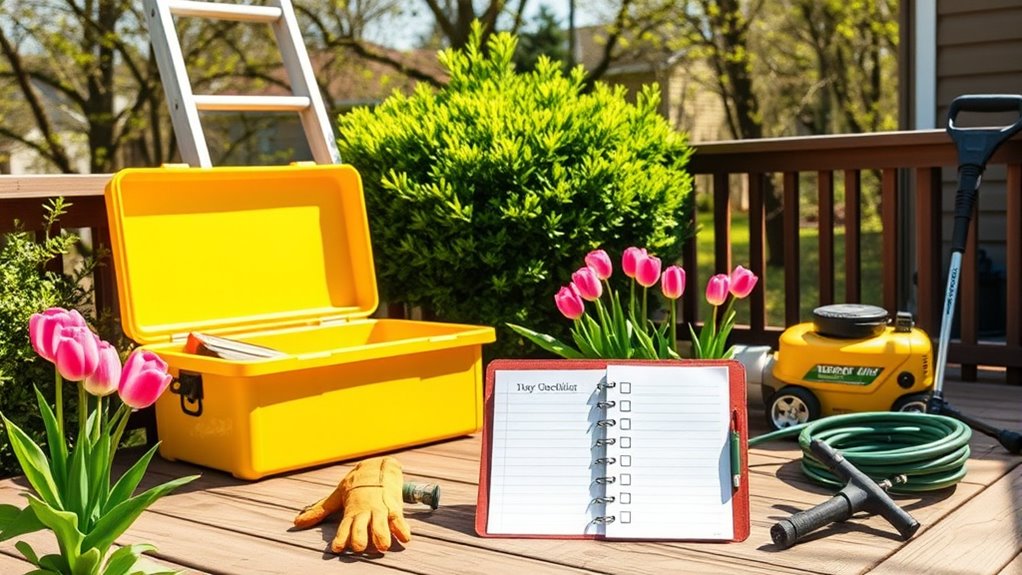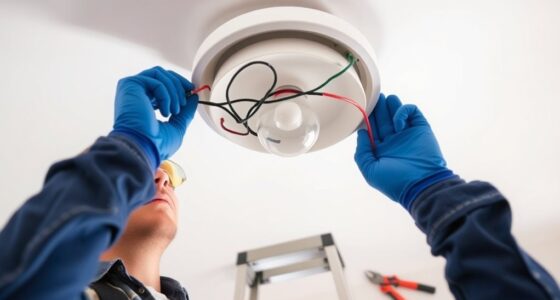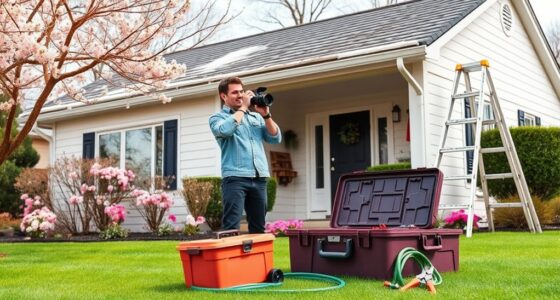To prepare your home for spring, start by inspecting and cleaning your gutters and downspouts to prevent water damage. Check your roof for any damage and service your HVAC system, replacing filters as needed. Refresh your exterior paint and siding for improved curb appeal. Don’t forget to inspect windows, doors, and safety systems. Finally, tidy up your lawn and organize indoor spaces. Keep going to discover more tips for a smooth seasonal progression.
Key Takeaways
- Inspect and clean gutters, downspouts, and roof for damage or debris to prevent leaks and water intrusion.
- Check windows, doors, and siding for damage; reseal, repaint, or repair as needed to improve energy efficiency and curb appeal.
- Service HVAC system, replace filters, and ensure proper operation for optimal indoor air quality.
- Maintain lawn and garden by fertilizing, pruning, weed control, and addressing pest issues.
- Test and update safety devices such as smoke detectors, carbon monoxide alarms, and sprinkler systems for home protection.
Inspect and Clean Gutters and Downspouts
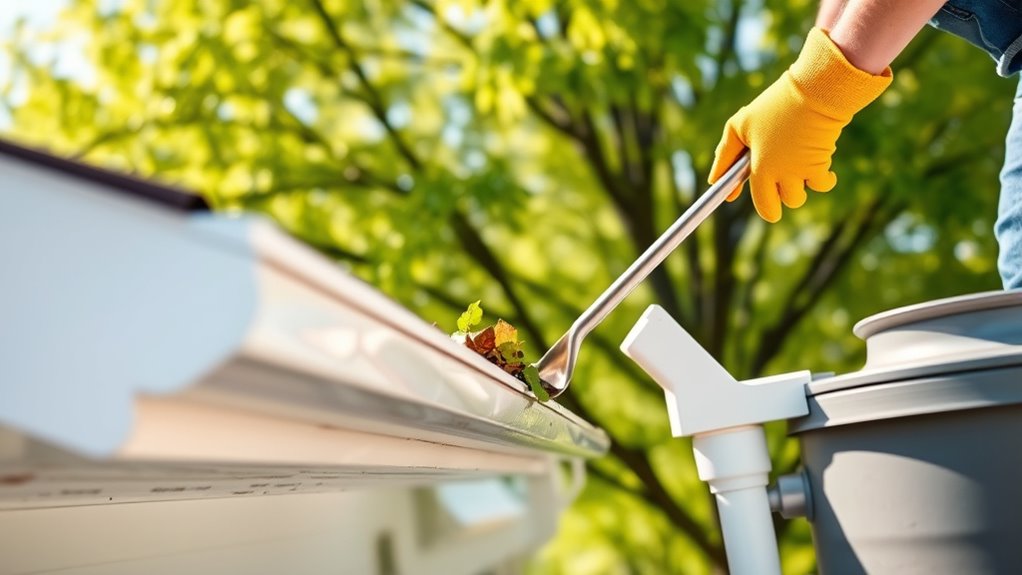
Spring is the perfect time to inspect and clean your gutters and downspouts to guarantee they function properly. Gutter maintenance is essential to prevent water damage and foundation issues. Start by removing leaves, twigs, and debris from your gutters with a sturdy scoop or garden trowel. Once clear, wash the gutters with a hose to flush out dirt and small debris that may be stuck. Don’t forget to check and clean the downspouts as well. Downspout cleaning ensures water flows freely away from your home’s foundation. Look for clogs or obstructions inside the downspouts and use a plumber’s snake or water hose to clear them. Proper gutter maintenance now helps avoid costly repairs later. Additionally, integrating AI-driven maintenance tools can help monitor gutter conditions and alert you to potential issues early on, ensuring optimal gutter performance. Regular inspections can also help identify clogged gutters before they cause significant problems, saving you time and money. Paying attention to gutter leaks and ensuring brackets are secure can further enhance their longevity and effectiveness. Incorporating preventive maintenance strategies can extend the lifespan of your gutters and prevent recurring issues.
Check the Roof for Damage and Leaks
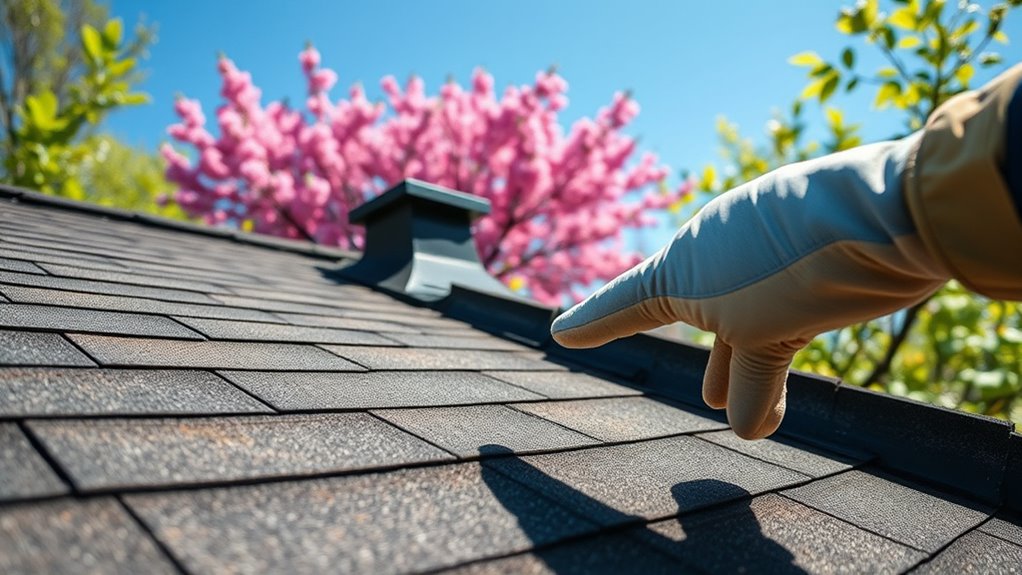
Have you ever wondered how much damage a hidden leak or unseen damage can cause? A thorough roof inspection is essential for early leak detection and to prevent costly repairs. Start by:
- Checking for missing or damaged shingles that compromise your roof’s integrity.
- Inspecting flashing around chimneys and vents for cracks or gaps.
- Looking for signs of water stains or mold inside your attic, indicating leaks.
- Examining the roof surface for curling, cracking, or granule loss that signals deterioration.
- Recognizing that water intrusion symptoms can often be mistaken for other issues, so prompt inspection is vital. Additionally, understanding roof deterioration signs can help homeowners identify problems early before they lead to major damage.
- Being aware that essential oils for roof health have no role in physical roof maintenance, but understanding the importance of regular inspections can help prevent deterioration. Regular inspections are also influenced by local building codes, which may require periodic assessments to ensure compliance and safety. Staying informed about building codes and regulations ensures your home remains safe and compliant with local standards.
Service the HVAC System and Replace Filters
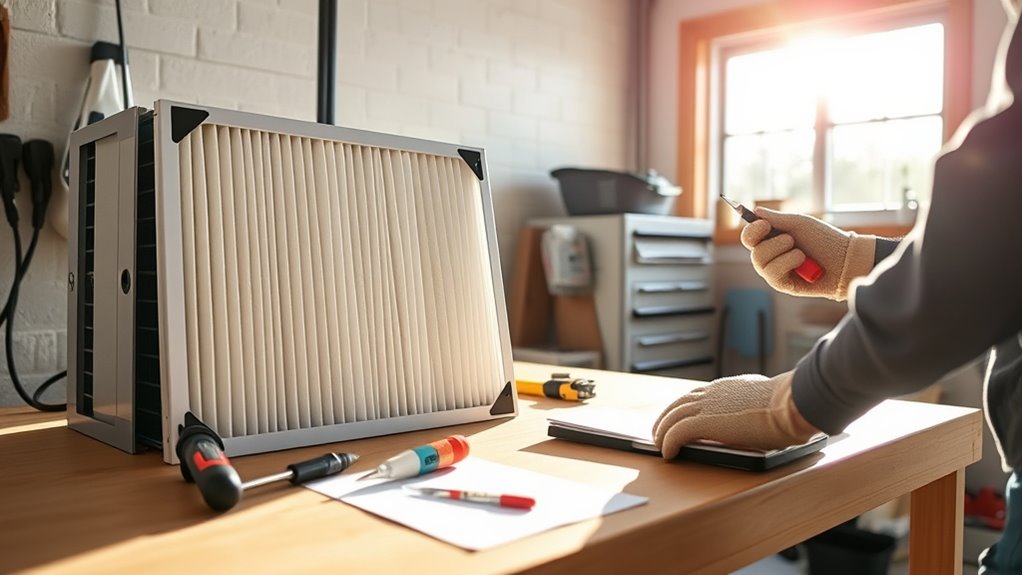
When was the last time you serviced your HVAC system? Regular HVAC maintenance guarantees your system runs efficiently and extends its lifespan. Start by replacing filters, which helps improve indoor air quality and energy efficiency. Check your filters monthly and replace them at least every three months, or sooner if they’re dirty. Proper filter replacement can prevent system strain and reduce energy bills. Additionally, using advanced filtration systems can further enhance indoor air quality and system performance. Ensuring your HVAC system is free from product buildup contributes to its optimal operation and longevity. Regular inspections can also help identify data privacy challenges issues early, preventing costly repairs down the line.
Refresh Exterior Paint and Siding

Start by inspecting your exterior paint and siding for any damage or cracks that need attention. Clean the surfaces thoroughly, then repaint or touch up areas to keep your home looking fresh. Don’t forget to repair any siding flaws to prevent further issues. Incorporating rustic decor elements can also enhance your home’s charm while maintaining its integrity. Additionally, staying informed about industry transformations like AI automation can inspire innovative approaches to home maintenance and upgrades. Embracing creative problem-solving can help you find effective solutions for repairs and improvements around your home.
Inspect for Damage
Inspecting your home’s exterior for damage is a crucial step in spring maintenance, especially when it comes to invigorating the paint and siding. Look for signs of storm damage, such as cracks or loosened panels, which can expose your home to further issues. Also, check for pest intrusion, like holes or nests, that could weaken siding. To stay thorough, consider these steps:
- Examine siding and paint for peeling, cracking, or bubbling.
- Look for loose or warped panels that may have been affected by storms.
- Inspect corners and seams for gaps where pests could enter.
- Check for water stains or mold that signal underlying damage.
- Ensure that exterior paint and siding are properly maintained to prevent deterioration and protect your home from weather-related damage. Regular inspections can also help you identify potential vulnerabilities early, saving you money on repairs. Additionally, inspecting for moisture issues can help prevent long-term damage caused by water intrusion. Addressing these issues early prevents costly repairs and keeps your home protected.
Clean and Repaint
Have you considered how a fresh coat of paint can instantly boost your home’s curb appeal? Repainting faded siding or peeling paint refreshes your home’s exterior and protects it from the elements. As you clean surfaces, don’t forget to inspect outdoor furniture for weather damage and consider repainting or sealing it. If you notice dull or chipping paint on your deck, deck staining can rejuvenate its appearance and prolong its lifespan. Using high-quality, weather-resistant paint can make a significant difference in durability and appearance. Regular maintenance with quality exterior paint can also prevent costly repairs down the line. Use the following table to plan your tasks:
| Task | Tips |
|---|---|
| Repaint Exterior | Choose weather-resistant paint |
| Clean Surfaces | Use a power washer for thoroughness |
| Deck Staining | Apply evenly for lasting protection |
This routine keeps your home looking sharp and ready for the season.
Repair Siding Flaws
To maintain your home’s exterior, addressing siding flaws is essential for both appearance and protection. Start by inspecting your siding for cracks, warping, or gaps. Then, follow these steps:
- Choose the right siding material based on your climate and style, considering options like vinyl, fiber cement, or wood.
- Clean the existing siding thoroughly to remove dirt and mildew, ensuring proper adhesion for repairs.
- Repair or replace damaged sections using proper siding installation techniques to ensure durability and a seamless look.
- Refresh the exterior paint or finish where needed, matching the existing color or opting for a new shade for enhanced curb appeal.
Proper siding material selection and installation techniques will keep your home protected and looking fresh all season long.
Inspect and Repair Windows and Doors

When spring arrives, it’s the perfect time to check your windows and doors for any signs of damage or wear. Start by inspecting window insulation; look for drafts or gaps that could let cold air in. Resealing or adding weatherstripping can improve energy efficiency and comfort. Check your door sealing as well—ensure the weatherstripping isn’t cracked or loose, which can cause drafts and increase heating costs. Test the locks and hinges to make sure they function smoothly, and repair any loose or damaged frames. Clear away debris around door thresholds and window sills to prevent moisture buildup. Taking these steps now will help you maintain a comfortable, energy-efficient home throughout the warmer months.
Clean and Maintain the Lawn and Garden Areas

Now is the perfect time to refresh your lawn and garden areas. Reseed and fertilize the grass to promote healthy growth, and prune trees and shrubs to keep them thriving. Don’t forget to weed and mulch beds to keep them tidy and protected from weeds.
Reseed and Fertilize Grass
Have you noticed bare or thin patches in your lawn after winter? It’s time to reseed and fertilize to boost grass health. First, identify these weak spots and loosen the soil. Second, scatter high-quality grass seed evenly over bare areas. Third, apply fertilizer to support new growth and strengthen existing grass. Fourth, water thoroughly to help seeds germinate and nutrients absorb. Proper fertilizer application encourages lush, healthy grass, filling in thin patches quickly. Reseeding now ensures a dense, vibrant lawn for summer. Keep the soil moist and avoid heavy foot traffic until the grass establishes. With these steps, you’ll improve your lawn’s overall health and create a beautiful spring landscape.
Prune Trees and Shrubs
Pruning trees and shrubs is essential for maintaining a healthy, attractive landscape. Proper tree trimming encourages growth, removes dead or diseased branches, and shapes the overall appearance of your yard. Focus on removing any crossing or rubbing branches to prevent damage. When shrub pruning, cut back overgrown or damaged stems to promote new growth and improve airflow. Use clean, sharp tools to make precise cuts and avoid harming your plants. Timing matters: prune early in the season before new growth begins. Regular pruning also helps control size and keeps your landscape looking tidy. Additionally, understanding the importance of proper pruning techniques can help prevent unintentional damage to your plants. By staying on top of tree trimming and shrub pruning, you’ll ensure your yard remains vibrant, healthy, and visually appealing throughout spring.
Weed and Mulch Beds
After trimming and shaping your trees and shrubs, turning your attention to weed and mulch beds helps maintain a tidy and healthy landscape. To keep these areas looking their best, consider these steps:
- Remove existing weeds by hand or with a weed control solution to prevent competition for nutrients.
- Apply mulch evenly around plants to suppress new weeds and retain soil moisture.
- Refresh mulch application annually to maintain its effectiveness and appearance.
- Check for any signs of pests or disease and address them promptly.
Test and Update Safety Devices and Systems

Spring is the perfect time to guarantee your safety devices and systems are working properly so you can enjoy a worry-free season. Test your fire alarm systems and perform smoke detector inspection to ensure they function correctly. Regular testing helps catch issues before emergencies happen. Keep in mind that batteries should be replaced annually, and units should be cleaned to prevent dust buildup.
| Safety Device | Test Method | Recommended Frequency |
|---|---|---|
| Fire alarm system | Fire alarm testing | Annually |
| Smoke detectors | Smoke detector inspection | Biannually |
| Carbon monoxide detectors | Function test | Annually |
| Sprinkler systems | System check | Annually |
| Emergency lights | Power and bulb check | Quarterly |
Prioritize these checks to safeguard your home and loved ones.
Declutter and Organize Indoor Spaces

Now that you’ve tested and updated your safety devices, it’s a great time to tackle clutter and organize your indoor spaces. Effective clutter control makes your home feel more spacious and safer. Start with these steps:
Once safety devices are updated, organize your home to create a safer, more spacious environment.
- Sort items into keep, donate, or discard piles to clear out unnecessary clutter.
- Invest in smart storage solutions like bins, shelves, or under-bed organizers to maximize space.
- Group similar items together—seasonal decor, tools, or electronics—for easier access.
- Regularly review and maintain your organization system to prevent clutter from building up again.
Frequently Asked Questions
How Often Should I Schedule Professional Roof Inspections in Spring?
You should schedule a professional roof inspection at least once every spring to assess roof durability and catch any damage early. Proper inspection timing guarantees you identify issues like leaks or weak spots before they worsen. Regular inspections help maintain your roof’s integrity, especially after winter storms. By staying proactive, you protect your home and extend your roof’s lifespan, keeping your investment secure year-round.
What Are Signs of Gutter System Failure I Should Watch For?
You should watch for signs of gutter system failure like gutter blockages, which cause water to overflow during heavy rain, and sagging gutters, indicating they’re pulling away from your home. Also, look for pooled water near your foundation or peeling paint on exterior walls. Regularly inspecting these issues helps prevent water damage, mold, and foundation problems, keeping your home safe and well-maintained throughout the season.
How Can I Improve Energy Efficiency After HVAC Maintenance?
Ever wondered how to keep your home energy-efficient after HVAC maintenance? You can boost it with insulation upgrades and window sealing. These improvements reduce heat loss and drafts, making your system work less and saving you money. Isn’t it worth investing in better insulation and sealing? By doing so, you create a more comfortable home, lower energy bills, and extend the life of your HVAC system.
What Are Eco-Friendly Options for Exterior Paint Touch-Ups?
When you look for eco-friendly options for exterior paint touch-ups, consider using eco friendly paints that are low in volatile organic compounds (VOCs). Natural paint alternatives, like clay or milk paint, also offer sustainable choices that reduce environmental impact. These options help you maintain your home’s appearance while supporting healthier air quality and minimizing chemical runoff. Switching to eco-friendly paints is a simple way to make your exterior maintenance more sustainable.
How Do I Prevent Pests From Entering Through Windows and Doors?
You might think pests are unavoidable, but you can keep them out by inspecting your window screens and door seals. Make sure screens are intact and free of tears, and replace any damaged ones. Seal gaps around doors with weatherstripping or new door seals. These simple steps create an effective barrier, preventing pests from sneaking in while keeping your home comfortable and pest-free during spring.
Conclusion
By completing these essential spring maintenance tasks, you’re setting the stage for a smooth, worry-free season. But beware—skipping just one step could hide hidden problems waiting to surface when you least expect them. Stay vigilant, and keep a close eye on your home’s condition. The small efforts you make today might just prevent a costly surprise tomorrow. Are you ready to uncover what’s lurking beneath the surface? The next step could be more revealing than you think.

